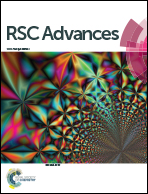Electrospun carbon nanofibers surface-grown with carbon nanotubes and polyaniline for use as high-performance electrode materials of supercapacitors
Abstract
This paper reports the synthesis and electrochemical performance of carbon nanofibers (CNFs) surface-grown with carbon nanotubes (CNTs) and nanostructured polyaniline (PANI) films, i.e., PANI/CNT/CNF, for use as a high-performance electrode material of pseudosupercapacitors. The PANI/CNT/CNF films were synthesized via in situ polymerization of aniline onto the surface of CNT-coated CNFs. The CNT-coated CNFs were prepared via electrospinning continuous polyacrylonitrile (PAN) nanofibers, followed by controlled carbonization and CNT growth. The morphology and microstructure of the PANI/CNT/CNF were characterized by means of scanning electron microscopy (SEM), transmission electron microscopy (TEM), and Raman spectroscopy. The electrochemical properties of the novel nanofiber films were characterized by electrochemical impedance spectroscopy (EIS), cyclic voltammetry (CV), and galvanostatic charge/discharge (GCD) in a 1 M aqueous H2SO4 solution as electrolyte. This unique porous nanofibrous structure exhibited low equivalent series resistance (ESR) and interfacial charge-transfer resistance (Rct) of 1.46 Ω and 0.55 Ω, respectively. Supercapacitors based on the present PANI/CNT/CNF electrodes behaved as with high specific capacitance of ∼503 F g−1 at a current density of 0.3 A g−1 and ∼471 F g−1 (only 6% decrease) at 3 A g−1. The maximum energy and power densities of ∼70 W h kg−1 and ∼15 kW kg−1 were achieved. In addition, over 92% of the initial capacitance was retained after 1000 charge/discharge cycles at a current density of 15 A g−1. The results of the present experimental study suggested that such a unique multifunctional nanofibrous material can be utilized for developing high-performance electrochemical energy storage devices such as pseudosupercapacitors, battery–supercapacitor hybrids, etc.


 Please wait while we load your content...
Please wait while we load your content...